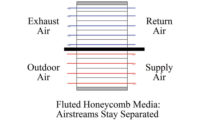The contractors were challenged to brace and maintain structural support of the second floor, and yet allow enough working space for the new radiator piping to be hidden within the structure. Jeff Persons, president, Geo Source One Inc., and his Columbus-based team were brought in for the repiping project and selected Aquatherm Blue Pipe® (formerly Climatherm) for the job because its flexibility allows it to be massaged through captive soffits and confined floor joists, where rigid pipe could not be easily fit and hung.
The home’s original heating system was a coal-fired boiler, which changed to oil and then finally to natural gas in the early 1960s. The boiler served over 3,000 square feet of the home with a gravity distribution system on double 3-inch mains, and cast iron radiators. A simple central power-pile thermostat controlled the aging gas valve, telling the massive boiler when to fire.
The latest boiler, installed in the 1960s, was a natural draft boiler with a 10-inch flue venting into a 30-foot chimney. The boiler was rated for 380,000 Btuh output and 480,000 Btuh input. The draft was calculated on the 10-inch flue at 711 cfm, made up by infiltration air to the structure. After accounting for standby losses, Carr was fortunate if 52 percent of the annual gas bill actually provided usable heat for the home.
The challenge for the repiping conversion was brought on by the major remodeling project that called for lowering the floor above the main basement and boiler area by 16 inches. This required removal of the boiler supply and return mains, and also the connection of the radiator run-outs to both the main and second floors. A total of 14 out of 20 radiator run-outs were directly affected and repiped as a result of the renovation.
Plastic Piping — A Better Solution
The old boiler was removed in sections and replaced with a 240,000 Btuh Triangle Tube Prestige TriMax boiler. The new sealed combustion boiler eliminated the excessive infiltration air requirement of the old boiler and is set to modulate its temperature based on an outdoor reset curve. A 60-gallon Triangle Tube Smart Series indirect domestic hot water heater couples with the TriMax boiler and ensures the customer will not run out of hot water.
Persons explained how the materials for the project were chosen: “For replacement of the old piping and radiator run-outs, we priced conventional black iron, copper, and Aquatherm Blue Pipe. The Aquatherm materials priced at about one third of the cost of black iron. Copper was so costly that it was no longer a consideration for anything but near-boiler piping.” Aquatherm is a German-manufactured polypropylene-random (PP-R) pipe system that is relatively new to North America, but has been proven in 70-plus countries for 40 years.
Blue Pipe, which is designed specifically for hydronic and radiant applications, was approved for Ohio commercial code for hydronic use and was approved for the residential application with the local building department. “Blue Pipe holds dimension with temperature changes. It was temperature- and pressure-rated for the application and was easily joined using the socket fusion method. We’re very familiar with that method through our work with fusion welding high density polyethylene pipe (HDPE) as geothermal system contractors,” said Persons.
“We found the Aquatherm much easier and faster to work with than HDPE that we’re familiar with,” Persons added. Aquatherm provided Geo Source One with support and training on the project.
Say Goodbye to Heavy Metal
The near-boiler piping was constructed from copper tube with Viega Pro-Press fittings to allow for the many boiler accessories — pumps, valves, sediment separators, and a special magnetic/cyclonic separator provided for the project from Fernox, a major European boiler treatment and water filtration company.
Over eight decades’ worth of iron sediment had accumulated in the old radiators and lines. Designing the near-boiler piping to allow for isolation of pumps and boilers while power flushing the old radiators was paramount to the success of the project, the reliability of the new high-efficiency boiler, and the wet-rotor Grundfos pumps.
The system was power flushed using a 1.5 hp centrifugal pump with 25-micron bag filters and 1¼-inch hose connections. Fernox F-3 was used as a system cleaning solution additive. Due to the heavy iron sediment in the old radiators, the bag filters would fill within five to 10 minutes of circulation and required frequent replacement. Once the system was running reasonably clear and had circulated for several hours, the boiler valves were opened up to allow circulation through the boiler and the Fernox Total Filter (TF-1) magnetic separator.
“After 16 hours of circulation with the magnetic separator in operation, we checked for debris in the total system sediment separator and found it to be clear,” Persons said. “The magnetic separator, however, had collected a full pint of inky black sediment from the system; an excellent testament to the capability of this type of device when there are ferrous materials present, compared to traditional sediment removal methods.”
Work on the project started in late September 2012 and was completed in early November 2012. About 200 feet of 1.5-inch, 200 feet of 1-inch, and 200 feet of ¾-inch Aquatherm Blue Pipe was used for the project. Persons estimated that using Blue Pipe resulted in a 70 percent savings in material and labor compared to using conventional methods.
Although it’s too early to report exact savings for an entire heating season, Carr reported better heat in all areas of the home. “We have no complaints with the temperatures in our home now. I’m impressed with this application of the non-traditional Aquatherm Blue Pipe. It’s helped solve our heating issues and it’s aesthetically pleasing as well.”
For more information, visit www.aquatherm.com.
Publication date: 11/4/2013
Want more HVAC industry news and information? Join The NEWS on Facebook, Twitter, and LinkedIn today!










